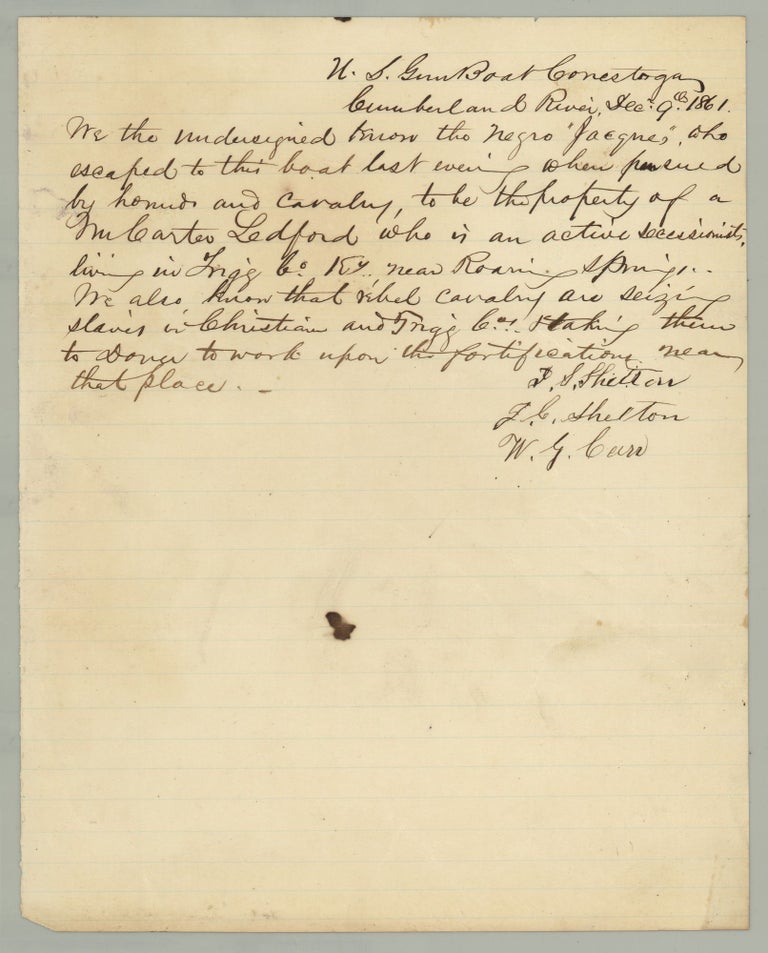We the undersigned know the negro “Jacques,” who escaped to this boat last evening…
U.S. Gunboat Conestoga, Cumberland River, [Tennessee], 9 December 1861. 9.75” x 7.7”. 1 p., in ink. CONDITION: Good, some creasing, one ink stain on verso that has bled through to the recto, but no losses to the text. A compelling affidavit composed by three Union sailors aboard the USS Conestoga of the Western Gunboat Flotilla noting their familiarity with a slave who fled to their ship and identifying the slave’s owner, composed early in the Civil War during the lead-up to the pivotal Battle of Fort Donelson (11–16 Feb. 1862). This affidavit reads in its entirety: U.S. Gun Boat Conestoga Cumberland River Dec. 9th 1861 We the undersigned know the negro ‘Jacques,’ who escaped to this boat [i.e., USS Conestoga] last evening when pursued by hounds and cavalry, to be the property of a Mr. Carter Ledford who is an active secessionist, living in Trigg. Co. KY, near Roaring Springs. We also know that rebel cavalry are seizing slaves in Christian and Trigg Cos. & taking them to Dover [Tennessee] to work upon the fortifications near that place [i.e., Fort Donelson]. [Signed,] J. S. Shelton, J. C. Shelton, W. G. Carr. During the war, some 275,000 slaves in Tennessee abandoned farms and towns in view of the approaching Union army. As Gen. Ulysses S. Grant’s army entered West Tennessee in the summer of 1862, many fugitive slaves flocked to the army’s protection. Grant ordered Chaplain John Eaton to establish a camp for the fugitives, many of whom had been supplying forced labor for the rebel army in the form of construction, acting as body servants, etc. Eaton established the first contraband camp at Grand Junction in August 1862. Two years later, contraband camps stretched across the Union-occupied parts of the Mississippi Valley, and freedmen were put to work for pay on abandoned farms, government-supervised plantations, and military projects. After its acquisition by the Union Army in June 1861, the USS Conestoga was converted to a 572-ton “timberclad” river gunboat (i.e., a wooden ship protected by a thick oak armor and between six and seven smoothbore guns). Conestoga became part of the Western Gunboat Flotilla (AKA the Mississippi River Squadron) and first saw action in September 1861 when she engaged CSS Jackson near Lucas Bend, Kentucky. In February 1862, she participated in an expedition with the Western Gunboat Flotilla up the Tennessee River that led to the capture of Forts Henry and Donelson (which guarded the Tennessee and Cumberland Rivers). The Western Gunboat Flotilla was commanded by Flag Officer Andrew Foote and also embraced four ironclad gunboats (flagship USS St. Louis, USS Carondelet, USS Louisville, and USS Pittsburgh) and two additional timberclad gunboats (USS Tyler and USS Lexington). The Battle of Fort Donelson (11–16 Feb. 1862) constituted one of the Union’s first major victories. A week after capturing Fort Henry on the Tennessee River, Brig. Gen. Ulysses Grant began his assault on Fort Donelson on the Cumberland River, an important gateway to the Confederacy. On 14 February, the Western Gunboat Flotilla attempted to reduce the fort with gunfire, but was forced to withdraw after sustaining heavy damage from the fort’s water batteries. On 16 Feb., after rebel forces under Brig. Gen. John Floyd failed to penetrate Grant’s lines, the rebels ceded the fort—meeting Grant’s terms of “unconditional and immediate surrender.” Grant’s victory ensured that Kentucky stayed in the Union and helped open up Tennessee to future Union advances. After the decisive capture of forts Henry and Donelson, Grant received a promotion to Major General and earned the nom de guerre “Unconditional Surrender Grant.” Later in the month of February 1862, the Conestoga saw action at Columbus, Kentucky, a rebel stronghold on the Mississippi River. During the rest of her service, Conestoga continued to operate along the rivers. She took part in the bombardment of Saint Charles, Arkansas in June 1862, and was formally transferred to the navy in October of that year. In April and July 1863, she was involved in expeditions to Palmyra, Tennessee, and up the Red River, Louisiana. The following March, she went up Louisiana’s Black and Ouachita Rivers. On 8 March 1864, Conestoga was sunk in a collision with USS General Price. A vivid document testifying to the hazards endured by runaway slaves during the Civil War. REFERENCES: Lovett, Bobby L. “Contraband Camps” at Tennessee Encyclopedia online.
Item #7751
Sold


